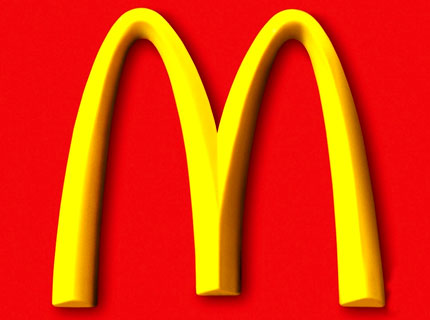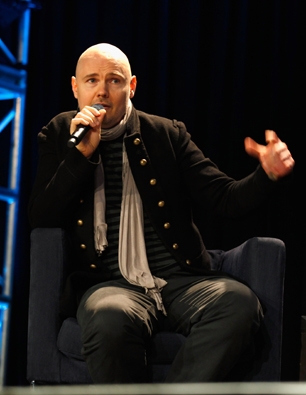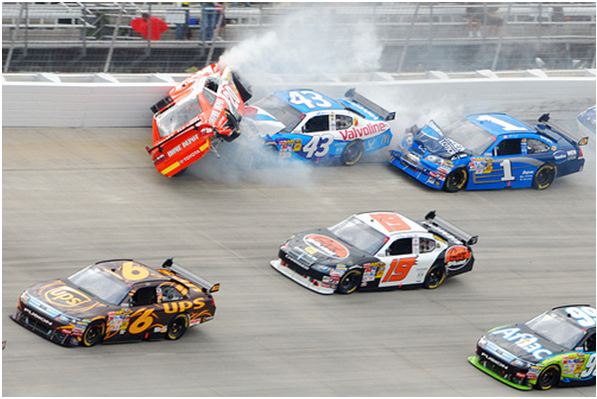The other day I noticed a highway billboard advertising a NASCAR race. The wall-sized photo was not of cars racing around a track or a cheering crowd. It was a photo of a gruesome wreck. At first, this seemed like an odd way to promote a sporting event! And yet, undeniably, our pulse quickens when those cars hit the wall, a fight breaks out at a hockey game, or when the seemingly infallible appear human.
This is a reflection on our normal tendency to focus on the negative. The negative is the news.
There is ample clinical research that codifies this trait, which is called Negativity Bias. Humans have a heightened physiological and psychological response to events they see as negative. Our attitudes are more heavily influenced by downbeat news than good news.
Our capacity to weigh negative input so heavily probably evolved for a good reason — to keep us out of harm’s way. The brain developed systems that would make it notice danger and hopefully, avoid it.
Negativity Bias in Action
But today, with so much stimuli coming at us each day, is it any wonder that when it comes to the social web, we may tend to focus on the spam, the haters, and the tragic, instead of the beautiful, spiritual and sublime?
We saw an example of Negativity Bias in action recently with the much-publicized McDonald’s “McFail” episode.
I respect McDonalds as a well-managed company that tries to do the right thing as it serves millions of diverse customers each day with predictable quality.
Although they are not my customer, I have in the past worked for two of their food suppliers and here is what I learned: No food processing company on earth has higher standards for quality, sustainability, animal treatment, and community involvement. No matter what you think of their food, this is a company that tries to do the right thing.
This carries over into social media, too. They are a gold standard in terms of authentic social media outreach and connection. How many companies of their size have a team of tweeters available for one-on-one conversation? In terms of effectively “humanizing” their brand, I use them as a best practice case study in my college classes.
#McFail
 So it came as a surprise when I started seeing headlines about the social media #McFail a few weeks ago. The story went something like this. McDonald’s has hosted a series of successful Twitter chats over the past few months and thought they would try something different. Under the hashtag of #McDStories they invited customers to tell their favorite stories of McDonald’s experiences.
So it came as a surprise when I started seeing headlines about the social media #McFail a few weeks ago. The story went something like this. McDonald’s has hosted a series of successful Twitter chats over the past few months and thought they would try something different. Under the hashtag of #McDStories they invited customers to tell their favorite stories of McDonald’s experiences.
As you might imagine, it didn’t take long to attract some negative stories and outcries from animal rights activists. It was probably naive on the company’s part to think that something like this might not happen.
But let’s look at the whole story. McDonald’s has made a genuinely positive attempt to be a “social” organization and I give them credit for experimenting by inviting their customers to engage. And even when one of their social media experiments did not go as planned, the company had something like 79,000 tweets and 2,000 of them were negative. So on one of their worst days, they had a positive sentiment analysis of 97.5 percent. In any company I’ve worked for, that would be cause for celebration.
And yet the all headlines focused on the failure. It will probably be a case study discussed for years alongside the Gap logo debacle. That may not be fair, but it’s what we need to anticipate from our society as we lay our social media plans over this layer of Negativity Bias.
We’re standing on digital quicksand
Every one of our organizations is standing on digital quicksand. It only takes one infinitesimal shift in customer sentiment, one outcry from a small number of passionate detractors, to dash an otherwise sterling reputation.
 One of the most interesting talks at SXSW was between Billy Corgan of the alternative rock band Smashing Pumpkins, and author Brian Solis. In the talk, Corgan hypothesized that artists take less risks today because of a realization that one embarrassingly human moment will get tweeted and go viral — and possibly kill a career. Before the social web, these moments might be laughed about and become part of band legend, but today it can be career-defining. He wondered aloud about a world where artists would be nothing more than politically-correct robots.
One of the most interesting talks at SXSW was between Billy Corgan of the alternative rock band Smashing Pumpkins, and author Brian Solis. In the talk, Corgan hypothesized that artists take less risks today because of a realization that one embarrassingly human moment will get tweeted and go viral — and possibly kill a career. Before the social web, these moments might be laughed about and become part of band legend, but today it can be career-defining. He wondered aloud about a world where artists would be nothing more than politically-correct robots.
The Vanilla Web
So as we acknowledge this reality, here is the question we need to consider very, very carefully when it comes to our own social media presence and taking risks in this space – is it worth it?
As we have seen many times, even an experiment that barely makes a dent in the company’s overall social footprint can overwhelm any good that is being accomplished, any sincere intentions, any attempt at innovation.
Personally or professionally, is it worth it trying anything new in the social space, even if you thought you could have a success rate of 97.5 percent? In a world where Negatively Bias is gasoline on a viral fire, and one misstep can overwhelm years of positive work cultivating raving fans, why would anybody take a risk on the social web?



